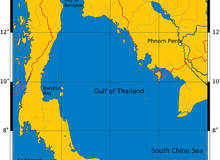
The Platong II gas development is a natural gas expansion project of the existing Platong complex in the Gulf of Thailand. The development involved the installation of a new gas receiving, processing and export platform and a new living-quarters platform.
First gas production from Platong II began in October 2011. The project doubled the natural gas production from the 10, 10A, 11 and 11A concession blocks in the Greater Platong area. It involved an investment of $3.1bn.
System de-bottlenecking and brownfield partnerships on the existing Platong complex were also carried out as part of the project.
The project is operated by Chevron, which owns 69.9% of the project; the remaining is held by Mitsui Oil Exploration (27.4%) and PTT Exploration and Production (2.7%).
Platong II platforms
The new platforms for Platong II were installed 120m offshore Thailand, adjacent to the existing Platong complex in shallow waters of 70m depth. Both platforms are linked to the existing facilities via a bridge.
The gas processing platform consists of two gas processing trains fully equipped with compression, dehydration, dew point control, mercury removal, condensate stabilisation and water-handling facilities.
The facilities operate at a nameplate capacity of 420 million standard cubic feet per day of sales gas, 22,000 barrels per day of condensate and up to 60,000 barrels per day of produced water. Approximately 30 remote wellhead platforms will be installed over the lifetime of the development.
The topside structures were installed using the float-over technique, a method used by Chevron for the first time in the Gulf of Thailand. Installation weight of the gas processing platform topsides is estimated to be 18,500t. Using the float-over technique, the entire topsides unit was loaded onto a barge taken to the installation site and floated over the installed jacket structure.
The living-quarters platform was either a separate facility installed over a fixed steel jacket south-east to the current living quarters or integrated with the central gas processing platform on the same steel jacket structure. Designed similar to the existing living quarters platform, the new living-quarters accommodates 200 beds.
Subsea systems
To provide gas and condensate to the new facilities, three new subsea trunk lines were laid as part of the project.
The 115km intra-field pipelines carry the three-phase reservoir liquids from the wellhead platforms to the central processing gas platform.
Gas processed, conditioned and compressed at the platform is exported through a new 24in sales gas pipeline, which is connected to the central gas processing platform via a 45km export trunkline. A condensate / oil pipeline was laid connecting the central processing gas platform with the pre-installed PLFSO Pattani Spirit.
Platong II output
The Platong II development produces natural gas, increasing the country’s gas processing capacity by 420 million cubic feet. The added capacity accounts for 14% of natural gas consumed for power generation in Asia Pacific.
The project was a major contributor in increasing Chevron’s daily contract production of natural gas to 1.2 billion in 2012. In an agreement with the Ministry of Energy of Thailand, Chevron agreed to boost its natural gas production by 500 million from offshore blocks 10, 11, 12 and 13.
Contractors for Platong II
The engineering, procurement, construction and installation (EPCI) contract for the project was awarded to the subsidiaries of J Ray McDermott.
The contract includes the entire EPCI scope associated with the gas processing platform, the living-quarters platform, flare tripod and three bridges.
The conceptual design engineering contract was awarded to WorleyParsons. The contract included the company’s Select phase conceptual design engineering services for the new facilities, front-end engineering and design, and procurement services including the acquisition of long -ead items.



